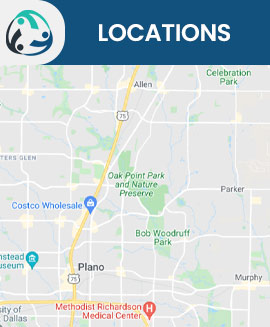Nerve Injury Treatment Specialist in Allen TX
Nerves are delicate and can be injured by pressure, stretching, or cutting. A nerve injury can interrupt messages to and from the brain, leading muscles to malfunction and no longer feel in the affected area. In the absence of proper treatment, nerve damage can worsen over time. If you are experiencing nerve injury and looking for the right treatment then visit American Pain and Wellness, our team of professionals would be pleased to serve you. For more information, contact us or schedule an appointment online. We are conveniently located at 1101 Raintree Cir #240, Allen, TX 75013 .


Table of Contents:
What kind of doctor do you see for nerve damage?
What happens if nerve damage goes untreated?
What helps repair nerve damage?
What are the 3 types of nerve injuries?
It is possible to experience various symptoms when your nerves are damaged. The only way to determine conclusively whether your nerves have been damaged is to consult a neurologist. In order to determine your muscle and nerve health, your doctor will perform tests. An explanation of the damage and its extent will be given by the doctor if there is a problem. A treatment plan will be devised following the evaluation.
Neurologists treat diseases of the brain and spinal cord (the central nervous system), peripheral nerves (nerves linking the brain and spine to organs, such as the lungs or liver), and muscles. The list of neurological diseases includes headaches, stroke, epilepsy, movement disorders, such as Parkinson’s disease and tremors, and different types of nerve damage.
If nerve damage is left untreated, it may worsen over time. It can sometimes begin in nerves that are farthest from the brain and spinal cord, such as those in the feet and hands. After that, it may move up into the arms and legs.
You may be able to reverse nerve damage if you receive treatment for the medical condition causing it. There are many cases in which nerve pain can be controlled. You should start by seeing your doctor for an assessment.
Nerve pain can be caused by a variety of factors, including uncontrolled diabetes, so it is important to identify the underlying cause and seek treatment. In addition to relieving your pain, it may slow or halt the progression of damage.
What will help to repair nerve damage will vary depending on the exact cause and nature of the nerve damage. There are many instances in which nerve damage cannot be completely cured. It is possible, however, to reduce your symptoms through various treatments.
As nerve damage is often progressive, it is important to consult a doctor when symptoms first appear. By doing this, you can reduce the possibility of permanent damage.
First, the underlying condition that is causing your nerve pain or damage must be addressed. In addition, your doctor may prescribe medications to minimize the nerve pain you are experiencing. Nerve pain and discomfort may also be alleviated through complementary and alternative approaches. And in some cases, surgery may be necessary in order to repair nerve damage.
When musculoskeletal trauma occurs, nerve damage can occur. There are three types of nerve injuries: (1) contusions (neuropraxic); (2) crushes (axonotmesis); and (3) transections (neurotmesis). The type of nerve injuries caused by closed fractures, dislocations, and blunt trauma is usually type 1 or type 2. It is rare for a closed injury to cause nerve transection. In most cases, closed traumatic nerve injuries are treated with simple observation in conjunction with fracture or dislocation care.
There is usually a good recovery from neuropraxic injuries within two to three months (except for those associated with knee dislocations). A crush injury may heal at a rate of about 2 cm per month, which is much more slowly than other types of injuries. It may be helpful to conduct electromyographic (EMG) studies in order to assess the recovery process.
Spiral fractures of the humerus, which result in wrist drops (radial nerve), and fractures of the fibula, which cause foot drops (peroneal nerve), are two common sites of injury of this type.
Exercises to maintain flexibility are included in treatment as well as periodic examinations to determine whether the condition has improved. Bracing (if needed) and stretching are also included in the treatment. Unless the demands are low, surgical exploration and repair are recommended if recovery does not occur. The majority of patients (95%) who suffer radial nerve injuries recover within six months.
Do you feel any pain, numbness, or tingling? You might have a nerve injury. It’s time to locate and fix the cause of your persistent discomfort! Nerve injury treatment is available at American Pain and Wellness. For more information, contact us or schedule an appointment online. We are conveniently located at 1101 Raintree Cir #240, Allen, TX 75013 . We serve patients from Allen TX, Plano TX, Fairview TX, McKinney TX, and surrounding areas.

Additional Services You May Need

Additional Services You May Need
• BACK AND NECK PAIN
• FACET INJECTIONS
• JOINT INJECTIONS
• PAIN MANAGEMENT
• REGENERATIVE MEDICINE
• PRP INJECTIONS
• HERNIATED DISC
• SPINE PAIN MANAGEMENT
• ARTHRITIS
• MUSCLE PAIN
• RHEUMATOLOGIC PAIN MANAGEMENT
• SACROILIAC JOINT PAIN
• NERVE PAIN
• ABDOMINAL AND PELVIC PAIN
• SPINAL STENOSIS
• SCIATICA TREATMENT
• PHYSICAL REHABILITATION THERAPY
• COMPLEX REGIONAL PAIN SYNDROME
• OSTEOARTHRITIS
• IMMEDIATE RELIEF FOR SCIATICA PAIN
• EPIDURAL STEROID INJECTIONS
• DYSTONIA
• CHRONIC PAIN
• CANCER PAIN
• AUTO ACCIDENT INJURY
• ARACHNOIDITIS




